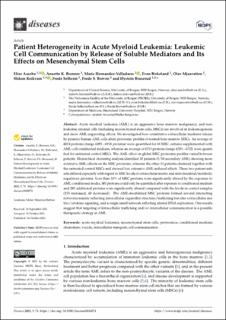| dc.contributor.author | Aasebø, Elise | |
| dc.contributor.author | Brenner, Annette | |
| dc.contributor.author | Hernandez-Valladares, Maria | |
| dc.contributor.author | Birkeland, Even | |
| dc.contributor.author | Mjaavatten, Olav | |
| dc.contributor.author | Reikvam, Håkon | |
| dc.contributor.author | Selheim, Frode | |
| dc.contributor.author | Berven, Frode Steingrimsen | |
| dc.contributor.author | Bruserud, Øystein | |
| dc.date.accessioned | 2022-04-06T11:12:12Z | |
| dc.date.available | 2022-04-06T11:12:12Z | |
| dc.date.created | 2021-11-08T14:35:39Z | |
| dc.date.issued | 2021 | |
| dc.identifier.issn | 2079-9721 | |
| dc.identifier.uri | https://hdl.handle.net/11250/2990185 | |
| dc.description.abstract | Acute myeloid leukemia (AML) is an aggressive bone marrow malignancy, and non-leukemic stromal cells (including mesenchymal stem cells, MSCs) are involved in leukemogenesis and show AML-supporting effects. We investigated how constitutive extracellular mediator release by primary human AML cells alters proteomic profiles of normal bone marrow MSCs. An average of 6814 proteins (range 6493−6918 proteins) were quantified for 41 MSC cultures supplemented with AML-cell conditioned medium, whereas an average of 6715 proteins (range 6703−6722) were quantified for untreated control MSCs. The AML effect on global MSC proteomic profiles varied between patients. Hierarchical clustering analysis identified 10 patients (5/10 secondary AML) showing more extensive AML-effects on the MSC proteome, whereas the other 31 patients clustered together with the untreated control MSCs and showed less extensive AML-induced effects. These two patient subsets differed especially with regard to MSC levels of extracellular matrix and mitochondrial/metabolic regulatory proteins. Less than 10% of MSC proteins were significantly altered by the exposure to AML-conditioned media; 301 proteins could only be quantified after exposure to conditioned medium and 201 additional proteins were significantly altered compared with the levels in control samples (153 increased, 48 decreased). The AML-modulated MSC proteins formed several interacting networks mainly reflecting intracellular organellar structure/trafficking but also extracellular matrix/cytokine signaling, and a single small network reflecting altered DNA replication. Our results suggest that targeting of intracellular trafficking and/or intercellular communication is a possible therapeutic strategy in AML. | en_US |
| dc.language.iso | eng | en_US |
| dc.publisher | MDPI | en_US |
| dc.rights | Navngivelse 4.0 Internasjonal | * |
| dc.rights.uri | http://creativecommons.org/licenses/by/4.0/deed.no | * |
| dc.title | Patient Heterogeneity in Acute Myeloid Leukemia: Leukemic Cell Communication by Release of Soluble Mediators and Its Effects on Mesenchymal Stem Cells | en_US |
| dc.type | Journal article | en_US |
| dc.type | Peer reviewed | en_US |
| dc.description.version | publishedVersion | en_US |
| dc.rights.holder | Copyright 2021 by the authors | en_US |
| dc.source.articlenumber | 74 | en_US |
| cristin.ispublished | true | |
| cristin.fulltext | original | |
| cristin.qualitycode | 1 | |
| dc.identifier.doi | 10.3390/diseases9040074 | |
| dc.identifier.cristin | 1952380 | |
| dc.source.journal | Diseases | en_US |
| dc.identifier.citation | Diseases. 2021, 9 (4), 74. | en_US |
| dc.source.volume | 9 | en_US |
| dc.source.issue | 4 | en_US |

